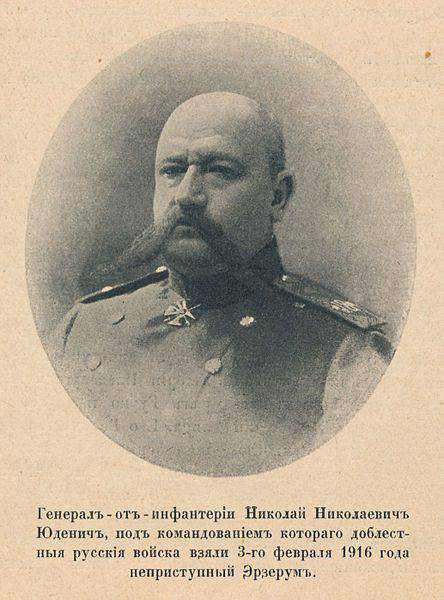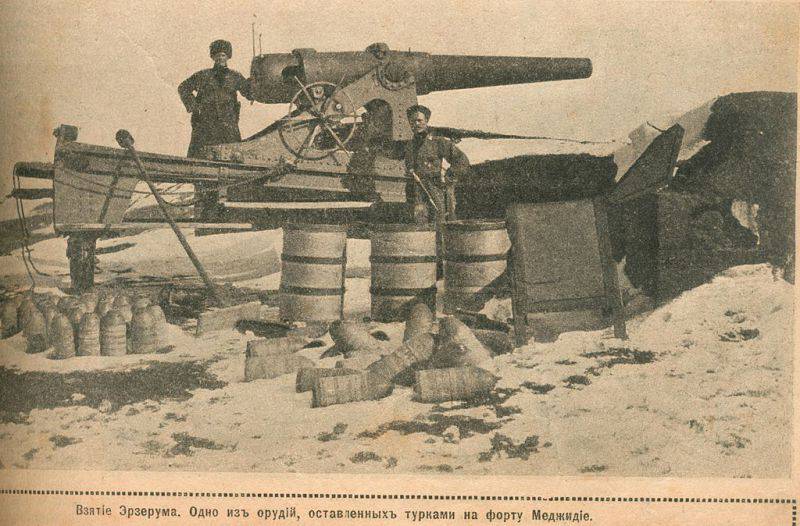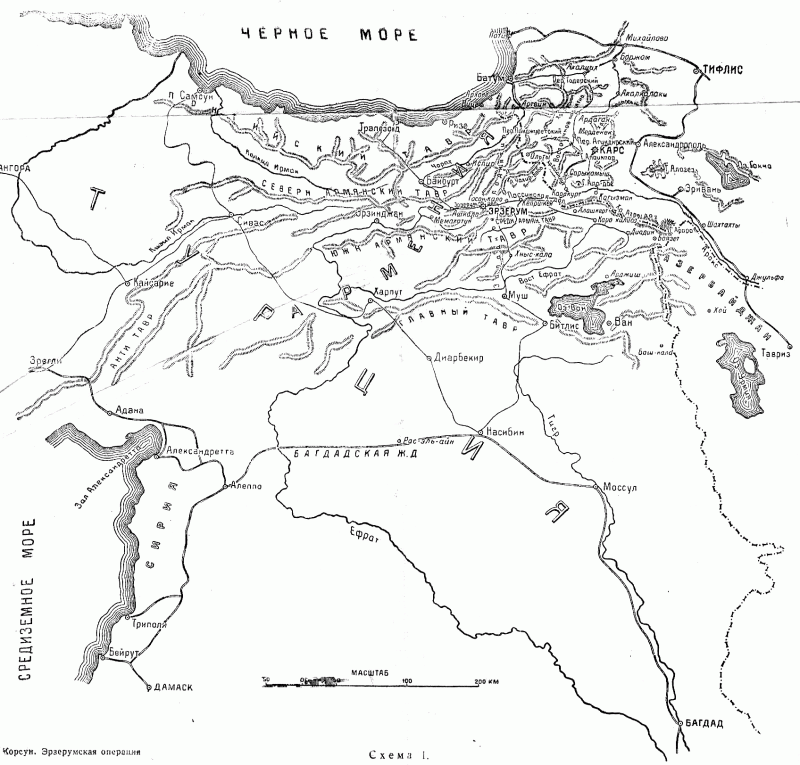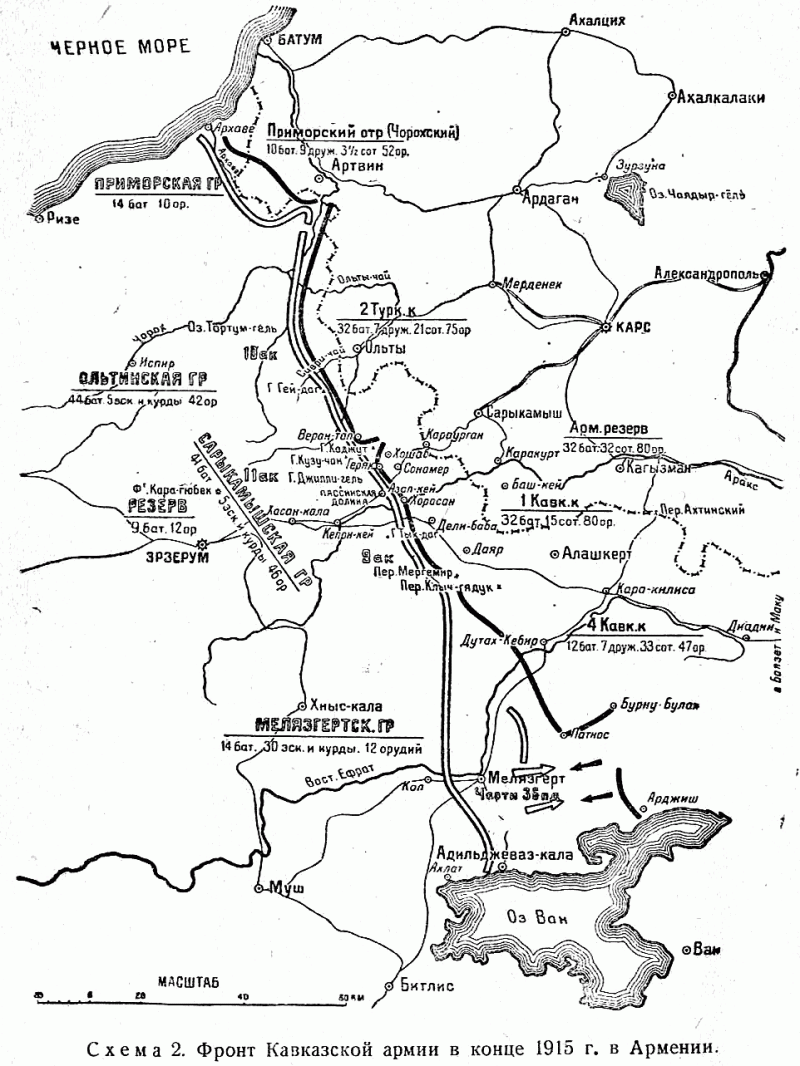Brilliant victory of the Russian Caucasian army under Erzerum
100 years ago, January 10 - February 16 1916, the Russian Caucasian army under the command of Nikolai Yudenich won a strategic victory in the Caucasus. In the course of the Erzerum battle, Russian troops in the difficult winter conditions at the mountain theater defeated the Turkish army 3 and captured the powerful Erzerum fortified area, which was the main supporting base of the Turkish army at the Caucasian theater.
At the same time, Yudenich overtook the upcoming Turkish offensive. The Ottoman command planned to transfer the corps freed after the victory in the Dardanelles to the Caucasian front and launch a major offensive in the spring of 1916. However, Yudenich made a real leadership decision: he launched the attack, despite the winter conditions, to destroy the military potential of the 3 of the Turkish army before reinforcements and not give the enemy time and opportunity to gather all his strength in the Caucasus.
General situation
The overall situation in the Middle East was extremely unfavorable for the Russian Caucasian army. She, as before, had to rely only on their own strength. The headquarters scornfully regarded the Caucasian front, considering it secondary. Therefore, troops were regularly removed from the Caucasus, they took away so meager ammunition. Despite the lack of manpower and resources, the Caucasian army during the 1914-1915 campaigns. was able to repel enemy strikes and move forward somewhat from the Russian-Turkish border, as well as stabilize the situation in Persia, sending Baratov's expedition there.
Britain and France sought to outrun Russia in the seizure of the straits and Constantinople, for which purpose the Dardanelles operation was undertaken in 1915. The “partners” of Russia did not want its military-strategic and economic gain at the expense of the Bosphorus, Dardanelles, Constantinople and Constantinople and Western (Turkish) Armenia. However, the Allied operation failed. The Anglo-French command underestimated the enemy. The operation to capture the Dardanelles and break through to Constantinople ended at the beginning of 1916 with complete failure and evacuation.
At the same time, the Entente powers, like the main thing - the European Theater, in the Middle East could not achieve consistency of actions. Each of the Allied powers jealously guarded against its foreign invasion the zone of its influence and acted independently. Russia acted in the Caucasus and Northern Persia, in Mesopotamia (with Iraq) and in Palestine - England, on the Syrian coast - France. At the same time, Britain was very much afraid of the further penetration of the Russians into the possessions of the Ottoman Empire. As a result, the Russian troops acted on their own, as the Anglo-French. This led to the fact that the weak Turkish armed forces could not only stand against the first-class troops of the world’s great powers, but also hit them hard. And Turkey, with the support of German agents, created a threat to the Entente powers in the zone of Persia, Afghanistan and on the borders of India.
Given the current situation at the end of 1915, the headquarters of the Caucasian Army considered the main task of the army, whose front from the Black Sea to the Tehran region was stretching to 1 500 km, to maintain its position through active defense. To this end, a regrouping was carried out, which was supposed to give a relatively significant "maneuverable reserve." The broad transition to the offensive of the entire Caucasian army was recognized as possible only after supplying it with combat supplies.
Along with the regrouping of the army and the creation of fortified positions from the Batumi area to the valley of the r. Eastern Euphrates, was preparing for a harsh winter period. Our troops strengthened the rear: a strong supply organization was created and a network of communications developed. By the end of 1915, due to the harsh and unpredictable winter in the mountains, with heavy snowfalls that completely blocked the communication lines and trails, traditionally combat activity stopped. The troops were in "winter quarters", preparing for the future campaign. Russians and Turks were limited only to intelligence. As a result, the impression was that such a stable position would be preserved until the spring of 1916.
In September, 1915 was replaced by a high command on the Caucasian front: the Grand Duke Nikolai Nikolayevich was appointed to replace the aged and departed Vorontsov-Dashkova, as commander and governor of the Caucasus. He was demoted, losing the post of commander in chief. The army itself was directly led by Nikolai Yudenich.
Oltinsky direction was occupied by the 2 th Turkestan Corps, Sarykamysh - 1 th Caucasian Corps, Erivan - 4 th Caucasian Corps. By November 15, the Caucasian Army proper numbered 111 ¼ battalions, 200 hundreds, 373 guns and, 8 militia and volunteer squads. The number of active army reached 184 thousand people (of which more than 27 thousand cavalry). In addition, the 14 1 / 2 battalions, 37 militia units, 49 hundreds were in the rear of the army subordinate to the chief commander of the Caucasian Military District. Only about 55 thousand bayonets and sabers. About another 69 thousand fighters were trained in 15 reserve battalions. By this time, the 3-I Turkish army, according to the headquarters of the Caucasian Army, consisted of 125 battalions, 40 squadrons, 8-10 thousand Kurds and 32 spare battalions.
Party plans
Ottoman Empire. The main forces of the 3 of the Turkish army, defending the Oltinsky and Sarykamysh directions, had the task to cover the best and shortest paths that led to Erzerum. This fortress was the supporting and operational base of the Turkish army, with which it was possible to attack Russian territories and defend the exit to Anatolia. It was a well-fortified "gate" to the Passinskaya valley and the valley of the Euphrates River. The fortress was the largest communications hub: from here the paths went to Batum, to Olty and Ardagan, from the Euphrates roads ran north to Trebizond and Reese, and south to Mush and Bitlis. Erzerum was the main control center and rear base of the 3 of the Turkish army, the fortress was tied together by the Turkish front in the Caucasus, allowed to maneuver forces and reserves.
The Turkish army received supply in two ways: sea - along the Black Sea coast and horse-drawn - along the mountain roads of Anatolia. However, both communications were weak. The Russian fleet dominated the sea. There were no normal roads on land, especially the situation was aggravated in winter. Therefore, the reinforcements that were released after the Dardanelles operation could be transferred only after the winter was over.
The Turkish army at the beginning of 1916 was somewhat inferior in size and in the quality of combat training and equipment to the Russian troops, but this was offset by a naturally strong position, which was reinforced by engineering structures. So, both flank of the Turkish army were reliably covered by nature: the left - the wild ridge of the Pontic Taurus, the right - even more powerful array of the Middle Armenian Taurus. The mountains were inaccessible in general, especially in the winter. As a result, the main forces of the Turkish army were firmly provided with mountains from rounds from both Batum and Erivan.
Russian troops had to attack in the forehead. The Turkish front, which stretched to 100 km, relied on the mountain frontiers in the basins of the Sivri Chai, Olty-Chai and Araks rivers. On these frontiers, the gay-dag, Kuzu-chan mountain, Gilli-gel mountain, the Azap-key plateau on the left bank of the river were of particular importance with regard to defense. Araks and mountain range Tyk-Dag. With such advantageous positions, the Turkish command was calm and was going to stubbornly defend itself on the frontier borders. However, the Ottomans hoped for the natural power of the border areas and did not provide for the Oltyinsky area strong fortifications of the rear mountain lines. In the Passinskaya valley on the Sarykamysh direction, the Turks created a rear defensive zone on the Keprikeisky isthmus. The next fortified frontier in advance was the fortified Erzerum, although the Turks could use another convenient defense line near the town of Hasan-Kala.
Thus, when the Russian army attacked in winter, before the arrival of the expected reinforcements from the strait region and Constantinople, the Turkish command expected to stop the enemy on the fortified frontier borders. The withdrawal to the Erzurum fortifications was not envisaged and the rear lines up to Erzurum itself were not prepared in advance.
According to the evidence of the Ottoman command, at the front by the beginning of the operation, due to the beginning of a harsh winter, “complete calm reigned” and any possibility of an enemy attack was excluded. Expecting a lull in the Caucasus, the Turkish-German command, which after the evacuation of the Anglo-French troops from Gallipoli, liberated the 20 divisions, decided to concentrate the superior forces against the British in Mesopotamia and do away with them until spring. In addition, to transfer part of the forces to Persia in order to force the Russians to weaken the Caucasian front proper and create a flank threat to the Russian army. In the spring, the Turks assumed, by concentrating a powerful shock fist of force, to break the resistance of the Russian Caucasian army on the main Sarykamysh direction and break through to Sarykamysh, Kars, Batumi, Erivani and Tiflis. Victory in the decisive battle allowed Turkey to establish its dominance in the Russian Transcaucasus.
Thus, for the Russian army was a dangerous situation. The Turkish command liberated large forces, which in the spring planned to transfer to the Caucasian front and organize a decisive offensive. Bulgaria acted on the side of the Central Powers, which led to the defeat of Serbia. This opened a direct link between Germany and the Ottoman Empire, which favorably affected the supply of ammunition to the Turkish army. The victory over the Anglo-French troops in the Battle of Dardanelles raised the morale of the Turkish army. In such a situation, the Russian army could not wait. It was necessary to attack the enemy.
Source of maps: Korsun N. Erzerum operation
Russia
The Russian command took into account that the allies were going to withdraw troops from the Dardanelles area. The Turks liberated large forces. According to various data that went to the headquarters of the Caucasian Army, it became clear that the Turkish-German command would throw part of the forces against the British in Mesopotamia, and part of it would send to the Caucasian front, where the main efforts of the Ottoman army would be concentrated in 1916. This was also reported by the British, who were alarmed for their army in Mesopotamia, where part of the British troops were blocked by the Ottoman army in the area of Kut-el-Amar (south of Baghdad).
Thus, it was obvious that in the first half of 1916, at the front of the Caucasian army, we should expect an extreme complication of the situation. Meanwhile, the Caucasian Army in 1915 was weakened by the allocation of significant reinforcements to the European theater, which led to the creation of new secondary formations and the deployment of 2 regiments of the Turkestan Corps and other personnel units. Therefore, it was extremely dangerous to wait for the spring offensive of the 3 of the Turkish army, reinforced by the best Turkish field units, which successfully repelled the Entente troops and had high morale.
Assessing the situation, the commander of the Caucasian army, General Yudenich, decided to make a commander: to go on a decisive offensive, despite the beginning of winter, cold and snow, to destroy the living force of the Turkish army before a strong reinforcements approach, not allowing the Turkish-German command to calmly concentrate the attack forces and go into a decisive offensive in the spring of 3
At the same time, it was necessary to accelerate the start of the operation in order to inflict a decisive defeat on the 3 of the Turkish army before reinforcements arrived, and to gain time to restore and strengthen positions. Since the arrival of fresh Turkish troops, with good morale, could weaken the results of the achieved victory and even destroy them. With the help of the military assistant of the governor in the Caucasus, General Nikolai Yanushkevich Yudenich, he managed to convince the vacillating Grand Duke Nikolai Nikolayevich that he was right. The offensive was scheduled for the Christmas holidays and on the eve of the new year, when the Turks would be least expected to attack Russian troops.
Nikolai Nikolayevich Yudenich decided to break through the defenses of the enemy right along the whole front. The Russian army was to go on a decisive offensive both on the Oltinsky direction and in the Passinskaya and Alashkert valleys. Three corps of the Caucasian army were to take part in the attack: the 2 and the Turkestan, the 1 and the 2. The main blow was struck in the direction of the village Kepri-Kay (Erzurum direction).
The offensive was supposed to begin on the Oltinsky direction of the 2 th Turkestan Corps two days earlier, in order to create the impression of a major strike on this sector. Then, the 1 Caucasian Corps launched an offensive, which was supposed to provide a breakthrough in the direction of the village of Keprik. He was reinforced by an army strike group. For the breakthrough of the Turkish defense, the 4-th Caucasian Rifle Division, which was in the army reserve, was allocated along with the 1-Caucasian Mortar Division and the Siberian Cossack Brigade, withdrawn for this purpose from the 2-th Turkestan Corps. So that the Turks could not carry out a maneuver by forces and transfer reserves to a dangerous direction, the forces of the Primorsky Detachment (Batumi Direction), 4 of the Caucasian Corps (Erivan Direction), Van-Azerbaijan Detachment (on the Van and Urmi Directions) and Expeditionary Corps in Persia (on the Kermanshah direction).
The forces of the parties
By the beginning of the operation, the Caucasian army had 126 1 / 2 battalions, 208 hundreds, 20 1 / 2 engineering companies, 52 militia units and 372 guns. The opposing 3 Turkish army consisted of 123 battalions, 40 squadrons and 8-10 thousand Kurds, 122 guns. The 3-I Turkish army deployed its main forces: the 5 infantry divisions of nine - on Sarykamysh direction and four - on Oltinsky. One division was in reserve.
The composition of the Russian battalions was stronger than the Turkish, it reached an average of 800 bayonets, and in the 39 Infantry Division exceeded the 1 000 bayonets, while the Turkish battalions averaged the 500 bayonets. As a result, the 3-I Turkish army was able to concentrate up to 60 thousands of bayonets to the area of operations, while the Russians possessed forces up to 75 thousands of bayonets.
Thus, with the approximate equality of forces in the infantry (in the number of battalions), the Caucasian army was superior to the enemy in artillery (three times) and in regular cavalry (five times). In addition, the Russians had aviation detachment, the Turks in this period did not have aviation at the Armenian Theater.
On the Oltinsky direction, the 2 th Turkestan army corps under the command of Przhevalsky was to attack. Opposite his right wing and center was the entire 10 of the Turkish corps, and against the left wing were parts of the 34 of the infantry division of the 11 of the Turkish corps. On the main Sarykamysh direction from the Russians, the 1 of the Caucasian Army Corps Kalitina advanced. The 33 and 18 infantry divisions of the 11 Turkish corps were stationed against its right wing and center, and the 28 and 29 part of the 9 corps infantry division were against the left wing. In addition, the Russian army had an army reserve in the Sarykamysh direction (32 battalion), from which an army strike group was organized. The Turks also had a weaker army reserve in the area of the city of Hasan-Kala (one division - 9 battalions). The Russian army had squadrons against 68 Turkish squadrons in Kurds, 10 guns against 235 Turkish in this direction.
As a result, the Russians concentrated on these two directions to 72% infantry, 65% artillery and 33% cavalry held in the Caucasian army, having 76% infantry against themselves, 82% artillery and 25% of the Turkish army. Thus, on the Oltinok and the Sarykamysh axes, the forces of the parties with regard to the infantry were relatively the same. However, the Russians had a significant army reserve, a force in the army corps (3 battalion), while the Turks had an entire infantry division (32 battalions) in reserve. In relation to the cavalry, the Russians outnumbered the Turks in these two directions by almost seven times and the artillery more than doubled. But the cavalry could not be used to the full because of the complexity of the winter, mountain theater and problems with the supply at a distance from the bases.
The right flank of the main grouping of the Caucasian army was provided by the Primorye detachment of Lyakhov (10 battalions and 9 squads), it could be supported by the ships of the Black Sea fleet. The left wing of the main forces of the Caucasian Army was provided by the 4th Caucasian De-Witt Corps.
Preparing for an operation
The offensive was prepared very carefully. Each soldier received valenki, warm foot-cloths, a sheepskin coat, trousers quilted on cotton wool, a hat with a roll-over head, mittens and an overcoat. In case of the need for covert movement, the troops received a significant amount of white camouflage and white covers on their hats. The personnel of the 1 Caucasian Army Corps, which was to attack at high altitude, so that the sun would not blind its eyes, were given goggles. Taking into account that the area of the upcoming battle was mostly treeless, and the supply of firewood was difficult, each soldier had to carry two logs with him to cook food and heat at night. There were forest areas only along the Black Sea coast and in the Sarykamysh area, whose forests became the fuel base of troops advancing in winter conditions. In addition, in the equipment of an infantry company, thick poles and boards for the device for crossing non-freezing mountain streams and rivulets became mandatory. He learned a lot from the sad experience of the Ottoman soldiers, during the Sarikamish operation thousands of Turkish soldiers froze and frostbite their feet because of wet shoes.
At the same time, much attention was paid to meteorological observation. The meteorological department, which served as inspector of the army artillery, General Slyusarenko, constantly analyzed the state of the weather, and issued its recommendations. By the end of the year, 17 meteorological stations were deployed in the army’s location zone. In the army rear big road construction unfolded. From Kars to Merdeken from the summer of 1915, a narrow-gauge railway mounted on horseback was operated. A narrow-gauge railway was built from Sarykamysh to Karaurgan on steam traction. Army transports were replenished with pack animals - horses and camels.
For better control at the time of the operation, Commander Yudenich decided to leave with his headquarters forward, closer to the troops, to the village Karahan, 20 km from the front. Through the efforts of special working columns, a new network for telegraph and telephone communication was built directly from Karaurgan in all major directions to the front. The construction of these lines passed secretly, under the guise of a correction and update of the old ones. Each building had a radio station.
Measures were taken to preserve the secret regrouping of troops. Mountain passes marching replenishment passed only at night, with the observance of blackout. In the area where it was planned to make a breakthrough, they carried out a demonstrative withdrawal of troops — the battalions took them to the rear during the day and returned at night. In order to misinform the enemy, rumors were spread about the preparation of an offensive operation by the Van detachment and the Baratov Persian Expeditionary Corps, together with British troops. In Persia, large purchases of food were carried out - grain, livestock (for meat portions), fodder and camels for transportation. And a few days before the start of the Erzerum operation, the commander of the 4 Caucasian Infantry Division was sent an urgent unencrypted telegram. There was an “order” in it about the concentration of a division near Sarykamysh and the transfer of its troops to Persia. But only one regiment of the division was transferred to the border Julfa. Where he made a demonstrative daily transition.
The army headquarters began to distribute leave to officers from the front, and also massively allow officer wives to come to the theater of operations on the occasion of the New Year holidays. Until the very last moment, the content of the planned operation was not disclosed to the downstream headquarters. Russian Stake was aware of the Erzerum operation, in order to maintain secrecy, only shortly before it began. The commander of the Caucasian army personally handed over the general decision on the launch of the offensive to the corps commanders, as well as to the commander of the 4-th Caucasian division, only on December 20 and orally. December 28 was to launch the 2 th Turkestan Corps, and on the night of 30 December 1915 the 1 Caucasian Corps.
A few days before the onset of the offensive, the exit of all persons from the front-line zone was completely closed, which should have prevented the Ottoman agents from informing the Turkish command of the full combat readiness of the Russian Caucasian Army and its final preparations. The frontline district of Olta, Kars, Kagyzman was isolated from the rear. On all roads leading from this area to the rear, outposts and cavalry patrols were put out, with categorical orders to let everyone into the specified area, but not to let anyone out of it to the rear.
As a result, the headquarters of the Caucasian Army outplayed the Ottoman command at the stage of preparing the operation, and the Russian attack on Erzerum came as a complete surprise to the enemy. The Ottoman command of the winter offensive of the Russian troops did not expect, considering that in the winter on the Caucasian front there was an inevitable operational pause. Therefore, the first echelons of the troops liberated in the Dardanelles began to be transferred to Iraq. There, Khalil Bey's corps was transferred from the Caucasian front, weakening the Turkish army's 3. In Istanbul, by spring, they hoped to crush the British forces in Mesopotamia, and then with all their might to attack the Russian army. The Turks were so calm that the commander of the 3 of the Turkish army in general went to the capital.

To be continued ...



Information